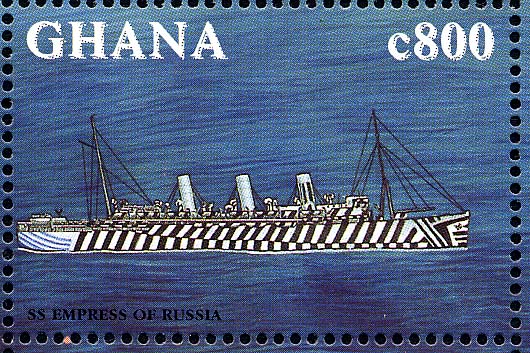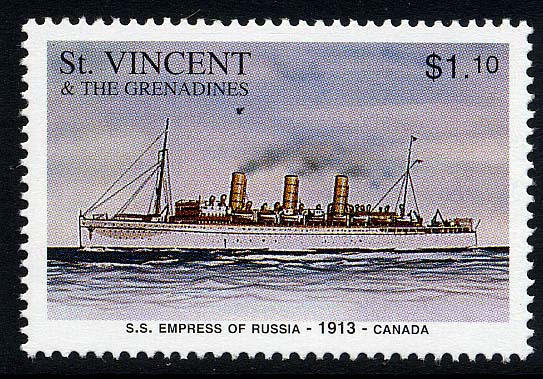

The Empress of Russia and her sister Empress of Asia represented the third generation of ships used by the Canadian Pacific Rly. Co. on their service between Western Canada and the Orient. This was opened by the C.P.R. in 1887 with three chartered vessels, the Abyssinia, Batavia and Parthia, all one-time Cunarders built in 1870 and of between 2,300 and 3,600 tons gross. They were replaced in 1891 by a trio specially designed for the trade—on which they immediately took premier position. These were the yachtlike Empress of India, Empress of Japan and Empress of China, 16-knot ships of just under 6,000 tons gross. They in turn eventually became out-classed by others, notably the very much larger ships of the Toyo Yusen Kaisha. But in 1913 such competition was more than met by the introduction into the trans-Pacific trade of the two new, three-funnelled Empress liners. Nearly three times the size of those they replaced, they were, incidentally, the world's first large liners to have cruiser sterns. Among Pacific ships, however, they were not quite the first, this feature having previously been incorporated in two Canadian National coastal ships, the 3,300-ton Prince George and Prince Rupert of 1910.
Both the Empress of Russia and her sister were built by the Fairfield Shipbuilding & Engineering Co. Ltd., Glasgow. The former was launched on 28 August, 1912, the other following three months later. Of 16,810 tons gross and 8,789 tons net, the Russia measured 590 ft in length overall (570.2ft b.p.) x 68 ft breadth mld x 46 ft mld to the shelter deck. The load draught was 29 ft and the hull was topped by a long, combined bridge and forecastle which extended for 394 ft. She had quadruple screws, each driven by a set of Parsons turbines. These took steam from six D.E. and four S.E. boilers which had a working pressure of 190 p.s.i. On trials, with a draught of 26 ft 8in., the Empress of Russia did 21.4 knots, just one knot above the speed stipulated. However, her nominal service speed was 19 knots, about 3 knots better than that of the Japanese ships. In the trans-Pacific trade, speed was of particular importance owing to the very high freights earned from the carriage of silk, the insurance rates for this being so high that every day saved had a considerable effect on the shipper' costs.
The passenger accommodation was reputedly equalled only by the finest Atlantic liners. It catered for about 200 first, l00 second and 800 steerage. The officers and crew numbered some 475. The main, first-class public rooms were on the promenade deck, the dome of the forward lounge rising between the forward and second funnels and that of the smoke room aft of the third stack. Also on that deck, but facing aft, was the first-class veranda café. Apart from these and the writing room, the promenade deck and the one below were devoted to first-class cabins, mainly two-berth. The shelter deck had a domed, 200-seat first-class dining saloon, the café and reception room for¬ward, the second-class dining saloon and the open decks for the second-class and steerage aft. The rest of the passenger cabins, both first- and second-class, were on the upper deck, the after part of which was devoted to steerage. Lessons having been learned from the Titanic disaster, the ship was exceptionally well sub-divided and it was claimed that she would remain afloat with any four compartments flooded.
On 1 April, 1913, the Empress of Russia left Liverpool on her long maiden voyage to the Orient via the Suez route. On her first trans-Pacific run made that May, she crossed from Yokohama to Vancouver in 8 days, 181/2 hours, a record which stood for nine years. As a reminder of conditions at that time it is worth recording that en route she called at Nagasaki where, in the space of 6 hours, local labour carried on board 3,200 tons of coal. With the commencement of the First World War the ship was requisitioned to spend about 18 months in the Indian Ocean, operating as an A.M.C. A brief return to commercial service was followed by a spell of trans-Atlantic trooping. By 1919 she was back on her old run and on this she continued until the winter of 1940-41. Then, after she had made 310 trans-Pacific crossings, she was once again requisitioned as a troopship and sent to the U.K. In September 1945, while undergoing a post-war refit at Barrow-in-Furness, she was gutted by fire and was subsequently broken up there by T. W. Ward Ltd. Her sister Empress of Asia was equally successful in service. In January 1941 she arrived at Vancouver on the conclusion of her 307th scheduled Pacific crossing and was requisitioned a month later for service as a troopship. In this capacity she was sunk off Singapore in February 1942 by Japanese aircraft.
Ghana SG2693, St Vincent SG3479.
Merchant Ships of the World.
